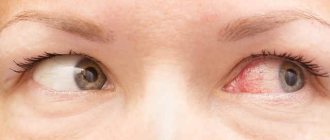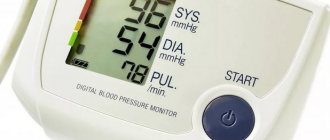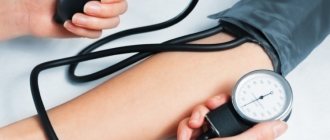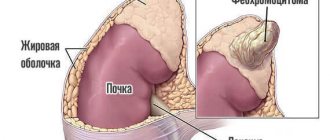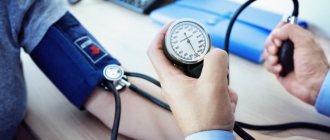Carrying a baby? This is a difficult, but quite pleasant process of waiting for the birth of your beloved baby. When you are in an interesting position, your body undergoes enormous changes that can affect the health of the expectant mother. It happens that doctors or you yourself detect high blood pressure during pregnancy. Dangerous? Or, perhaps, there is no need to panic, because this is a completely normal process? We will look into this issue in our article.
Hypertension during pregnancy: norms and deviations
Every woman should know her usual blood pressure (BP). For some it may be lower than 120/80, for others it may be slightly higher.
When visiting your leading gynecologist, your blood pressure is measured every time. Of course, such manipulations are not carried out without reason - excessively high blood pressure can signal an unfavorable condition for the patient and the fetus.
Normal blood pressure during pregnancy varies between 100/60-140/90. An increase in this indicator by 15% shows the following picture:
- blood vessels constrict
- there is excessive strain on the heart muscle
- the fetus stops growing due to lack of oxygen
- placental insufficiency may develop
- Cases of placental abruption in the early stages have been recorded.
Is it possible to influence your own blood pressure?
How do hypotensive patients usually increase their blood pressure? The first thing that comes to mind is special medications. But their action is harmful to the unborn child. The effect of such drugs is to narrow the blood vessels. But this necessarily affects the blood supply to the fetus. Together with the blood, the baby does not receive enough nutrients necessary for growth. As a result, there is a risk of developmental defects.
This means we need to look for other ways to cope with the pressure. There are many of them, and they should be used in combination.
- For dizziness and weakness caused by low blood pressure, it is good to lie down for a while with your legs elevated. Blood will flow from the lower extremities to the upper body. The brain will be saturated with oxygen, and your health will improve. By the way, this pose is also useful for preventing varicose veins.
- Another quick way to raise blood pressure is a contrast shower. You need to finish the procedure with cold water.
- Three minute rule. When you wake up, you don’t need to immediately jump out of bed. This can cause a sharp drop in pressure. It’s better to lie down for at least another 3-5 minutes and then get up. You can even eat something right there, in bed. It is convenient to keep a small food supply on the bedside table: crackers, bread or dry biscuits.
- To keep your blood vessels in good shape, you should not neglect physical exercise for pregnant women, swimming and other acceptable physical activities.
- Sometimes you can afford to drink a cup of coffee, but not too strong. Sweet tea can also help. A few slices of chocolate are a good “cure” in this case.
- Another secret is proper nutrition. You need to eat in accordance with the dietary recommendations for expectant mothers. Eat food often, but in small portions.
- Don't forget about the drinking regime. Sometimes it happens that the doctor insists on limiting fluid intake, for example, due to kidney problems. But if there is no such restriction, you need to drink more water and juices. It is better to discuss the exact amount of drinking with your pregnancy doctor.
- And finally, perhaps the simplest and most accessible way to raise blood pressure is to walk more. Fresh air significantly improves your well-being. Not only does blood pressure go up, but also mood, which is also important for the expectant mother.
Causes of high blood pressure in expectant mothers
Hypertension during pregnancy can occur due to the influence of various factors. Among the most common causes, doctors identify:
- genetic predisposition
- nervous shock
- alcohol and smoking abuse during pregnancy
- dysfunction of the adrenal glands and thyroid gland, as well as diabetes mellitus
- poor nutrition
- obesity.
Of course, to record the increase in pressure, you can use a tonometer, which will accurately determine your blood pressure. If this is not at hand, hypertension can be identified by the appearance of tinnitus, poor health, and the appearance of “energy floaters.” before the eyes and covering the face with red spots.
How to increase blood pressure without medications
An alternative to medications is physical therapy. A neurologist will tell you how to increase blood pressure without medications, suggesting that you undergo physiotherapy procedures that are suitable for the pregnant woman based on her health condition. Electrophoresis and electrosleep, procedures using a weak current discharge, under the supervision of a doctor, will level blood pressure without causing harm to the fetus. To improve blood circulation and saturate the skin with oxygen, water procedures will help. The sanatoriums will offer:
- pearl baths:
- turpentine baths;
- brine baths
- balneotherapy (using mineral waters).
What does high blood pressure indicate in the 1st and 3rd trimester?
If in the early stages the pressure reaches 140/90, and such an increase is observed regularly, then we can talk about the presence of hypertension associated with the course of pregnancy itself and disruptions in the functioning of the endocrine system.
Frequent high blood pressure in the 3rd trimester may indicate gestosis, which impairs blood flow and the functioning of individual organs. In the risk group, gynecologists include women who have infections, intoxication of the body, and nervous disorders.
Negative manifestations of high blood pressure:
- cardiac arrhythmia
- constant swelling
- vision problems
- constant weakness
- placental abruption
- rejection of the fetus by the female body (in addition to high blood pressure, increased protein in the urine and excessive weight gain are added).
How to prevent gestosis (preeclampsia)
PRE-ECLAMPSIA (HEREINAFTER PE) is a multisystem pathological condition that occurs in the second half of pregnancy (after 20 weeks), characterized by an increase in blood pressure and protein content in the daily urine, which can lead to complications both in the body of the pregnant woman and fetus
All attempts to explain the causes and mechanisms of preeclampsia to date have not yielded any clear results. However, it is now generally accepted that the placenta plays a key role in the development of this pathology. In the very process of its formation, an error occurs in which the modeling of the blood vessels of the placenta is disrupted, after which the transport of substances through the placenta occurs with an error, and in response to this it begins to produce special compounds to show that it is working hard. These substances enter the mother’s body and trigger a cascade of pathological changes.
This pathology is insidious, often begins without complaints or symptoms, so it is quite difficult to predict it. As a rule, PE begins after 20 weeks, most cases occur in the 3rd trimester of pregnancy and the postpartum period.
RISK FACTORS FOR PE DEVELOPMENT:
- first pregnancy
- multiparous (history of PE, break after last birth of 5 or more years)
- multiple pregnancy
- pregnant woman's age > 35 years
- overweight/obesity (body mass index > 25 kg/m2)
- family history (PE in the mother/sister of a pregnant woman)
- extragenital diseases of the pregnant woman (pre-pregnancy arterial hypertension, kidney disease,
- diabetes mellitus, vascular diseases, APS, collagenosis, SLE).
!!! According to recent studies, this special formation of the placenta, which was mentioned above, occurs on the basis of the interaction of the genes of the mother and the fetus. This suggests that there is a hereditary predisposition to PE on both the maternal and paternal lines. It has been established that in 30-35% of cases the genes of the pregnant woman play a role, in 20% the genes of the fetus and in 13% a combination of the genes of both parents. This means that for men born from women with preeclampsia, their wife may be more likely to experience it during pregnancy... so sometimes it’s even useful to communicate with your mother-in-law)))
CRITERIA FOR DIAGNOSIS:
- occurs after 20 weeks of pregnancy
- increased blood pressure above 140/90 mmHg. (at the same time, the criterion is also an isolated increase in systolic pressure >140 mmHg, or diastolic pressure >90 mmHg)
- proteinuria (the amount of protein in daily urine > 300 mg)
In the future, symptoms of damage to other systems may occur: impaired renal function (creatinine > 97.2 µmol/l, oliguria), liver (increased levels of ALAT, AST, LDH by at least 2 times), hematological complications, acute lung damage, edema, HELLP /ELLP syndrome, central nervous system damage (eclampsia, etc.). All this is already a criterion for severe PE and entails fetal suffering (oligohydramnios, negative non-stress test, FGR syndrome, antenatal fetal death).
!!! Edema in itself is not a criterion for PE. An important role is played by assessing the rate of growth and area of spread of edema. This helps to assess the severity of PE, but does not make this diagnosis.
DIAGNOSTICS:
- blood pressure measurement (pressure increase with double measurements with an interval of at least 4 hours)
- determination of protein in daily urine (> 300 mg)!!!
- In severe forms of PE, markers of damage to other systems, which every gynecologist knows about, can be added. The patient herself can help by measuring her blood pressure at home herself, taking the urine test that the doctor prescribes (even if it’s tedious/strange/difficult) and coming to the appointment with the frequency the doctor asks for.
!!! YOU SHOULD TELL YOUR DOCTOR ABOUT THE FOLLOWING SYMPTOMS:
- nausea and/or vomiting
- pain in the epigastrium and/or right hypochondrium
- rapid weight gain > 500 g/week)
- appearance/worsening of edema
- Strong headache
- visual impairment
- confusion
- dyspnea
- change in the nature of fetal movements
ONLY WITH COMPETENT COLLABORATION WILL IT BE ABLE TO CORRECT THIS CONDITION IN TIME.
TACTICS OF MANAGEMENT OF PATIENTS WITH PE
The main idea is that the cause of PE is pregnancy, therefore, the sooner the pregnancy ends, the sooner recovery will occur.
With moderate PE, at the initial stage there is always hospitalization and a search for a suitable medicine to correct blood pressure, monitoring the condition of the fetus. Everything in this situation is aimed at prolonging pregnancy and preventing complications.
In case of severe PE - hospitalization, decision on delivery after stabilization of the pregnant woman, if possible after prevention of fetal RDS, and transfer of the woman to a higher level of medical care.
Caesarean section is not the mandatory choice for delivery of PE. The method of delivery is selected based on the gestational age, readiness of the birth canal, and the condition of the pregnant woman and fetus.
PREVENTION
- healthy eating, normal body weight and moderate weight gain during pregnancy, physical activity
- taking aspirin 75 mg/day from 12-36 weeks of pregnancy (for women at risk for PE, prescribed by the attending physician)
- calcium intake 1.5-2 g/day from the 12th week of pregnancy (prescribed by the attending physician, the dosage is determined based on the patient’s diet)!!!
There is no evidence base and is not recommended for the prevention of PE: multivitamin complexes, separately vitamins C and E, fish oil, salt and fluid restriction, diuretics, progesterone, heparin, magnesium sulfate, garlic, leeches, bed rest.
Modern scientists are now actively working on the problem of PE; a number of substances have already been isolated by which the placenta signals that there is a problem. All efforts are focused on finding methods for early diagnosis of these compounds and ways to neutralize them. Therefore, we will believe in the power of science, and also work on each pregnancy as a friendly team of patients and doctors, where everyone hears and respects each other (and yes, this applies to both sides).
How to treat?
There are the following ways to lower blood pressure:
- taking pills (read the instructions carefully or consult a leading gynecologist - Papazol, Egilok, Dopegit and others)
- avoiding stress (for example, you can do yoga for pregnant women)
- traditional medicine (decoctions based on rose hips, dill seeds, taking pumpkin with honey)
- preparation and consumption of vitamin cocktails (beetroot, pomegranate, carrot, pumpkin and cranberry juice)
- exclusion from food of spicy, salty and sweet foods, as well as coffee and chocolate
- place some support under your feet when you are lying down and resting
Thus, eliminating high blood pressure will not be difficult. You just need to undergo an examination and consult with your doctor.
Foods that increase blood pressure
A proper diet will help regulate tone, strengthen the walls of blood vessels, and normalize blood flow. It is advisable to eat 4-5 times a day, in small portions. Take dietary recipes as a basis: meat (fish) + vegetables + fruits. Carbohydrates lead in the rate of absorption, but you should not consume them in large quantities. A small piece of chocolate or honey will help you quickly restore your well-being. Foods to increase blood pressure should be:
- healthy, containing iron;
- healthy, containing flavonoids;
- rich in proteins.


